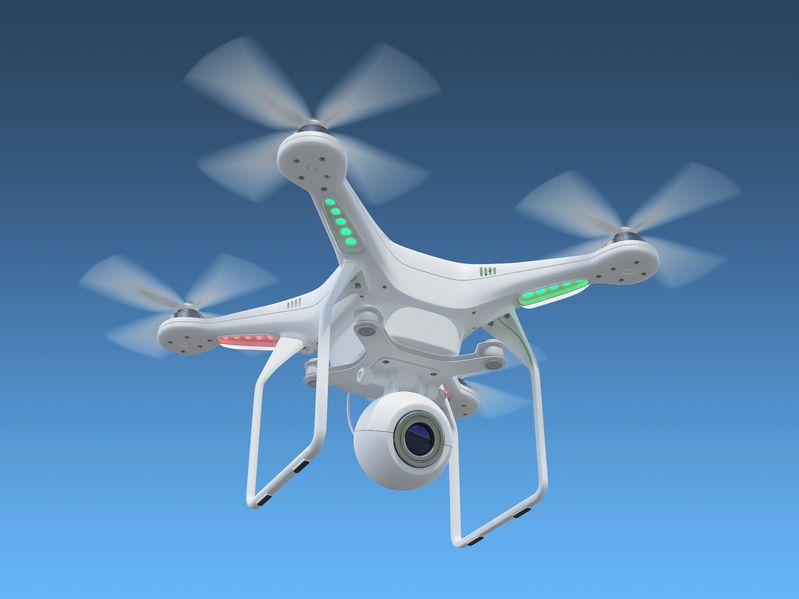Welcome to the fascinating world of drones! These incredible flying machines have captured our imaginations and are revolutionizing industries across the globe. Whether you’re a tech enthusiast, an aspiring pilot, or simply curious about this cutting-edge technology, you’ve come to the right place. In this comprehensive guide, we will take you on a thrilling journey through the history, mechanics, applications, and future possibilities of drone. So buckle up and get ready for an exhilarating ride as we explore all things drones!
The history of drones
The history of drones is a fascinating journey that traces back to the early 20th century. While many may think of drones as a recent invention, their origins can be found in the development of remote-controlled aircraft during World War I and II.
During these wars, engineers and inventors began experimenting with unmanned aerial vehicles (UAVs) for reconnaissance purposes. These early prototypes were crude by today’s standards, but they laid the foundation for the sophisticated drone we see today.
In the following decades, drone technology continued to evolve. In the 1960s, the United States military developed the first true UAV called “Bee” or “Bug,” which was used for surveillance missions during Vietnam War.
As technology advanced, so did drone capabilities. The 1990s saw significant improvements in navigation systems and data transmission, making drones more reliable and efficient than ever before. This opened up new possibilities for civilian applications such as aerial photography and surveying.
In recent years, the drone has become increasingly popular among hobbyists and professionals alike. Their affordability and ease of use have made them accessible to a wider audience beyond the military and commercial sectors.
Today, the drone is used in various industries including agriculture, filmmaking, search and rescue operations, and package delivery services – just to name a few! With advancements in artificial intelligence (AI), we can expect even more exciting developments in drone technology in the coming years.
The history of drones is one filled with innovation and progress. From humble beginnings as remote-controlled aircraft to versatile tools used across numerous fields today – it’s clear that drone has come a long way since their inception.
How do drones work?
How do drones work? It’s a question that has fascinated many, and the answer lies in the intricate technology that powers these flying machines. At their core, drone is unmanned aerial vehicles (UAVs) controlled remotely or autonomously.
The first important component of a drone is its flight controller. This small yet powerful device acts as the brain of the drone, allowing it to maintain stability and control its movements in the air. The flight controller receives signals from various sensors such as accelerometers, gyroscopes, and magnetometers to determine the drone’s position and orientation.
To achieve flight, the drone relies on multiple rotors or propellers. These spinning blades generate lift by pushing air downwards, enabling the drone to hover or maneuver through different directions. The number of rotors can vary depending on the type of drone – quadcopters have four rotors while hexacopters have six.
For navigation purposes, drone often utilize GPS (Global Positioning System) technology. GPS allows them to accurately determine their location in real time and follow pre-programmed routes if needed. Additionally, some advanced drone is may incorporate obstacle avoidance systems using infrared sensors or cameras for enhanced safety during flights.
Communication between the remote pilot and the drone is crucial for control. A transmitter sends commands wirelessly to a receiver on board the aircraft which interprets those instructions into actions like ascending, descending, or changing direction.
Powering all these components are batteries specifically designed for drones’ high energy demands. Lithium polymer (LiPo) batteries are commonly used due to their lightweight nature and ability to deliver sufficient power for extended flight durations.
In essence, drone combines cutting-edge technology with aerodynamic principles to provide stable flight capabilities with precise controls. Whether used recreationally or professionally across various industries like photography/videography agriculture monitoring search & rescue efforts or package delivery it’s clear that these fascinating machines continue revolutionizing our world!
The different types of drones
The world of drones is vast and diverse, with a wide array of different types to suit various needs and purposes. From small hobbyist drones to advanced military UAVs, there is a drone for every application.
One popular type of drone is the quadcopter, which gets its name from the four propellers that enable it to fly. Quadcopters are commonly used for aerial photography and videography due to their stability in flight.
Another type of drone gaining popularity is the fixed-wing drone. Unlike quadcopters, these drone has a more traditional airplane-like design with fixed wings. Fixed-wing drone is known for their long-flight endurance and are often used in surveying large areas or monitoring wildlife.
For those interested in underwater exploration, there are also underwater drones available. These submersible vehicles allow users to capture stunning footage beneath the water’s surface or conduct research in marine environments.
In addition to these mainstream types, there are specialized drones designed for specific industries such as agriculture (agricultural spraying), construction (surveying and inspection), and even delivery services (package transportation).
Each type of drone has its own unique features and capabilities, making them suitable for different tasks. Whether you’re an enthusiast looking to capture breathtaking aerial shots or a professional seeking efficient solutions for your business, there’s sure to be a drone out there that meets your needs!
Drone applications and uses
Drone applications and uses are rapidly expanding across various industries, revolutionizing the way tasks are accomplished. From aerial photography to search and rescue missions, drones have proven to be versatile tools in a wide range of fields.
In the realm of cinematography, drones have opened up new possibilities for capturing breathtaking shots from unique perspectives. With their ability to maneuver through tight spaces and reach high altitudes, filmmakers can now achieve shots that were once only possible with expensive equipment or helicopters.
In agriculture, drones equipped with advanced imaging technology can monitor crop health, detect pests or diseases, and optimize irrigation systems. This not only improves efficiency but also reduces costs associated with manual labor and chemical use.
The construction industry has also embraced drone technology for site surveys and inspections. Drones can quickly gather topographic data, inspect structures for damage or safety hazards, and provide real-time information to project managers without risking human lives.
Search-and-rescue operations benefit immensely from drone capabilities as well. Equipped with thermal cameras and GPS tracking systems, drones can cover large areas quickly while providing live video feeds to aid in locating missing persons or assessing disaster zones.
Drones are even being used in the delivery sector by companies like Amazon. With their ability to navigate busy urban areas efficiently and deliver packages within a short time frame, they offer an innovative solution to traditional logistics challenges.
These examples barely scratch the surface of how drones are transforming various industries. As technology advances further alongside regulatory developments ensuring safety measures are in place – we can expect even more exciting applications to emerge in the future!
The future of drones
As technology continues to advance at a rapid pace, the future of drones looks incredibly promising. With each passing year, we see new and exciting developments that push the boundaries of what these unmanned aerial vehicles can do.
One area where we can expect significant growth is in the commercial sector. Companies are increasingly recognizing the potential benefits of using drones for various tasks such as delivery services, infrastructure inspections, and agricultural monitoring. As regulations become more accommodating and drone technology becomes more sophisticated, we can anticipate an influx of innovative applications that will revolutionize industries across the board.
In addition to their growing use in business settings, drones are also becoming popular among hobbyists and enthusiasts. With advancements in camera technology and flight control systems, recreational drone users now have access to high-quality aerial photography and videography capabilities like never before. This opens up endless creative possibilities for capturing stunning images from unique perspectives.
Furthermore, researchers are constantly exploring ways to enhance drone capabilities through artificial intelligence (AI). We may soon witness drones equipped with autonomous navigation systems that allow them to intelligently navigate complex environments without human intervention. This could be particularly useful for search-and-rescue missions or disaster relief efforts where time is critical.
Another aspect worth mentioning is the ongoing development of swarm robotics – a concept inspired by natural formations like flocking birds or schooling fish. By leveraging collective intelligence algorithms, swarms of drones could work together seamlessly on large-scale projects such as mapping terrains or conducting surveillance operations efficiently.
However, as exciting as it all sounds, there are still challenges ahead for the widespread adoption of drones. Issues related to privacy concerns, safety regulations, and air traffic management systems integration need careful consideration before fully embracing this technology’s potential.
The future holds immense opportunities for further innovation within the world of drones – from their increasing use in various industries to advancements in AI-powered autonomy and swarm robotics capabilities. While there are obstacles yet to overcome regarding regulation and safety, it is clear that drones will continue to play a significant role in
Conclusion
Drones have revolutionized numerous industries and opened up a whole new world of possibilities. From their humble beginnings as military tools to becoming accessible to the general public, drones have come a long way.
In this comprehensive guide, we’ve explored the fascinating world of drones. We delved into their history, understanding how they work and the various types available in the market today. We also discovered the wide range of applications that drones are being used for across different sectors.
As technology continues to advance at an incredible pace, it is safe to say that the future holds even more exciting developments for drones. With improvements in battery life, artificial intelligence capabilities, and regulatory frameworks adapting to accommodate drone usage, we can anticipate seeing drones play an even bigger role in our lives.
Whether it’s capturing breathtaking aerial shots or delivering packages with pinpoint accuracy, drones have proven themselves as versatile tools capable of enhancing our daily lives in countless ways.
So next time you hear a buzzing sound overhead or catch sight of an unmanned aircraft soaring through the skies, take a moment to appreciate just how far these remarkable devices have come – and ponder on what amazing feats they will achieve next!
Remember: The sky is no longer the limit when it comes to exploring all that drones have to offer!








1 thought on “Exploring the Fascinating World of Drones: A Comprehensive Guide”